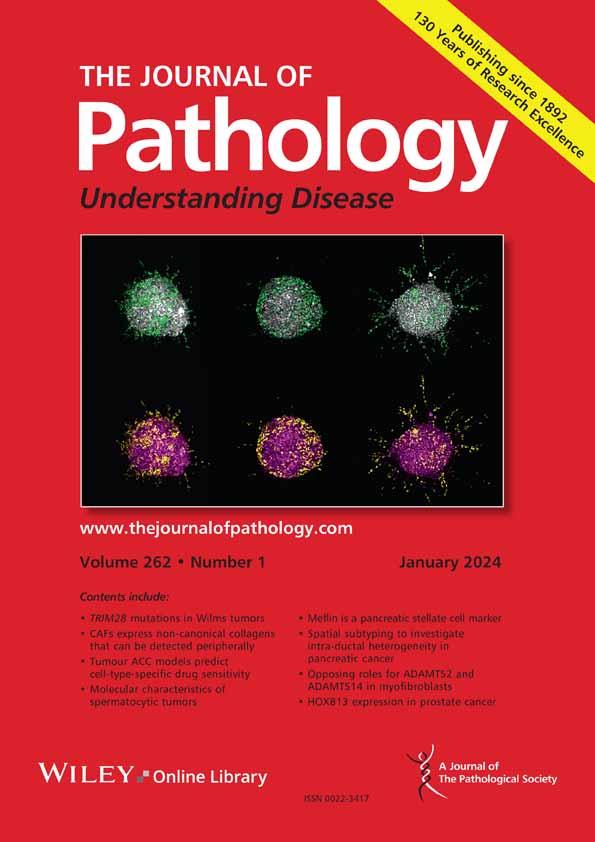下载PDF
{"title":"Cancer-associated fibroblast heterogeneity in chordoma†","authors":"Jack C Henry, Angus J M Cameron","doi":"10.1002/path.6420","DOIUrl":null,"url":null,"abstract":"<p>In solid tumours, malignant cells develop relationships with nonmalignant stromal cells to support tumour growth, tissue structure, and nutrient supply. In a recent issue of this journal, Zheng and Guo catalogue the cellular landscape in chordoma using a combination of single-cell and spatial transcriptomics. Despite the mesenchymal nature of chordoma, malignant cells retain expression of epithelial markers, in addition to mesenchymal, partial-EMT, and stem-cell signatures. Cancer-associated fibroblasts (CAFs) are among the most abundant stromal cells and the authors define an inflammatory CAF subtype (iCAF), which is associated with poor outcome and tumour invasion. It is proposed that iCAFs arise from normal fibroblasts during malignant tumour progression and play a causative role in driving an invasive poor prognosis tumour phenotype. Recent reports by this and other groups have separately catalogued cell populations, including CAFs and immune cells in chordoma. The next challenge will be to integrate findings from these distinct studies to allow a consensus to be reached regarding cellular heterogeneity within chordoma, and to allow comparison of CAF populations with those found in other tumour types. Comparison of CAF functions in these predominantly mesenchymal tumours with epithelial solid tumours may reveal interesting lessons about the diverse phenotypes CAFs can bring to distinct tumour ecosystems. Understanding the role of CAFs in chordoma progression may also lead to therapeutic opportunities, but separation of correlation and causation in CAF regulation of tumour phenotypes remains a significant challenge. © 2025 The Author(s). <i>The Journal of Pathology</i> published by John Wiley & Sons Ltd on behalf of The Pathological Society of Great Britain and Ireland.</p>","PeriodicalId":232,"journal":{"name":"The Journal of Pathology","volume":"266 1","pages":"5-8"},"PeriodicalIF":5.2000,"publicationDate":"2025-03-15","publicationTypes":"Journal Article","fieldsOfStudy":null,"isOpenAccess":false,"openAccessPdf":"https://onlinelibrary.wiley.com/doi/epdf/10.1002/path.6420","citationCount":"0","resultStr":null,"platform":"Semanticscholar","paperid":null,"PeriodicalName":"The Journal of Pathology","FirstCategoryId":"3","ListUrlMain":"https://pathsocjournals.onlinelibrary.wiley.com/doi/10.1002/path.6420","RegionNum":2,"RegionCategory":"医学","ArticlePicture":[],"TitleCN":null,"AbstractTextCN":null,"PMCID":null,"EPubDate":"","PubModel":"","JCR":"Q1","JCRName":"ONCOLOGY","Score":null,"Total":0}
引用次数: 0
引用
批量引用
Abstract
In solid tumours, malignant cells develop relationships with nonmalignant stromal cells to support tumour growth, tissue structure, and nutrient supply. In a recent issue of this journal, Zheng and Guo catalogue the cellular landscape in chordoma using a combination of single-cell and spatial transcriptomics. Despite the mesenchymal nature of chordoma, malignant cells retain expression of epithelial markers, in addition to mesenchymal, partial-EMT, and stem-cell signatures. Cancer-associated fibroblasts (CAFs) are among the most abundant stromal cells and the authors define an inflammatory CAF subtype (iCAF), which is associated with poor outcome and tumour invasion. It is proposed that iCAFs arise from normal fibroblasts during malignant tumour progression and play a causative role in driving an invasive poor prognosis tumour phenotype. Recent reports by this and other groups have separately catalogued cell populations, including CAFs and immune cells in chordoma. The next challenge will be to integrate findings from these distinct studies to allow a consensus to be reached regarding cellular heterogeneity within chordoma, and to allow comparison of CAF populations with those found in other tumour types. Comparison of CAF functions in these predominantly mesenchymal tumours with epithelial solid tumours may reveal interesting lessons about the diverse phenotypes CAFs can bring to distinct tumour ecosystems. Understanding the role of CAFs in chordoma progression may also lead to therapeutic opportunities, but separation of correlation and causation in CAF regulation of tumour phenotypes remains a significant challenge. © 2025 The Author(s). The Journal of Pathology published by John Wiley & Sons Ltd on behalf of The Pathological Society of Great Britain and Ireland.
脊索瘤中癌症相关成纤维细胞的异质性†。
在实体瘤中,恶性细胞与非恶性基质细胞相互作用,支持肿瘤生长、组织结构和营养供应。在最近一期的该杂志中,郑和郭使用单细胞和空间转录组学相结合的方法编目了脊索瘤的细胞景观。尽管脊索瘤具有间充质性质,但除了间充质、部分emt和干细胞特征外,恶性细胞还保留上皮标记物的表达。癌症相关成纤维细胞(CAFs)是最丰富的基质细胞之一,作者定义了一种炎症性CAF亚型(iCAF),它与预后不良和肿瘤侵袭有关。研究人员提出,icaf起源于恶性肿瘤进展过程中的正常成纤维细胞,并在驱动侵袭性预后不良的肿瘤表型中发挥致病作用。这个小组和其他小组最近的报告分别对细胞群进行了分类,包括脊索瘤中的CAFs和免疫细胞。下一个挑战将是整合这些不同研究的结果,以便就脊索瘤内的细胞异质性达成共识,并将CAF群体与其他肿瘤类型的CAF群体进行比较。比较CAF在这些主要是间充质肿瘤和上皮实体肿瘤中的功能,可能会揭示CAF在不同肿瘤生态系统中所能带来的不同表型的有趣经验。了解CAF在脊索瘤进展中的作用也可能带来治疗机会,但分离CAF调节肿瘤表型的相关性和因果关系仍然是一个重大挑战。©2025作者。《病理学杂志》由John Wiley & Sons Ltd代表大不列颠和爱尔兰病理学会出版。
本文章由计算机程序翻译,如有差异,请以英文原文为准。






 求助内容:
求助内容: 应助结果提醒方式:
应助结果提醒方式:


